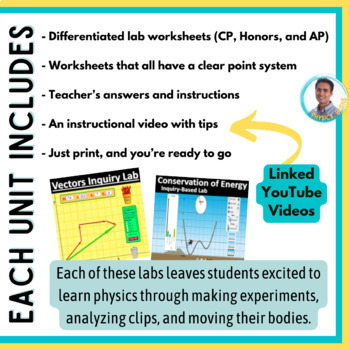HIGH SCHOOL PHYSICS | Entire Year Lab Bundle | NGSS Curriculum
- Zip
What educators are saying
Products in this Bundle (30)
showing 1-5 of 30 products
Bonus
Description
Full High School Physics Lab Curriculum. Every lab is editable, so you can tweak things to fit your classroom perfectly. Each of these labs requires only basic materials.
Here are all the labs that I do with my Regular, Honors, and AP Students. Each lab comes with worksheets that are differentiated depending on your students. Students who are doing these labs should at least have an understanding of basic algebra and geometry. Each of these labs leaves my students excited to learn physics through making experiments, analyzing clips, and moving their bodies. Every year these are the labs I provide to my students who often tell me that physics has become their new favorite class!
Topics:
One Dimensional Kinematics - 5 Labs Included
Vectors - 4 Labs Included
Projectile Motion - 3 Labs Included
Newton's Laws - 3 Labs Included
Uniform Circular Motion - 3 Labs Included
Energy and Work - 3 Labs Included
Momentum - 2 Labs Included
Electric Forces - 2 Labs Included
Circuits - 1 Lab Included
Simple Harmonic Motion - 2 Labs Included
Every Lab Includes [FULLY EDITABLE]:
- Lab worksheets differentiated (CP, Honors, and AP)
- Worksheets that all have a clear point system
- Teacher’s answers and instructions
- An instructional video with tips
- Just print, and you’re ready to go
Check out my Youtube Channel, Facebook Group, and Follow my Store :)





